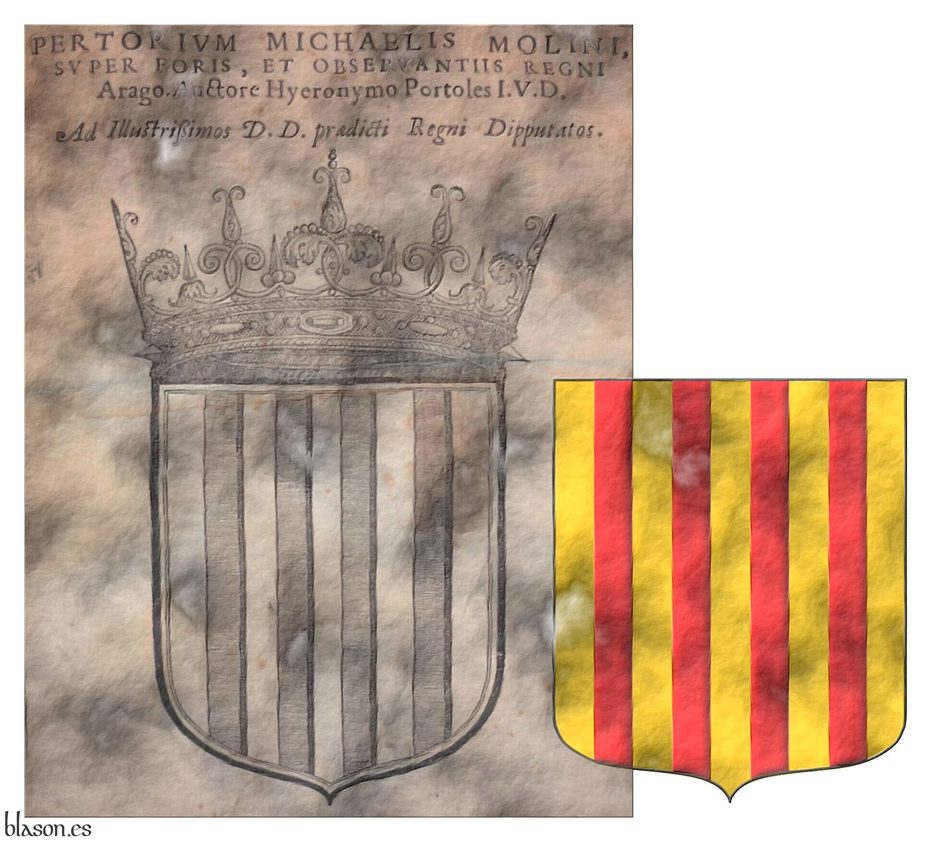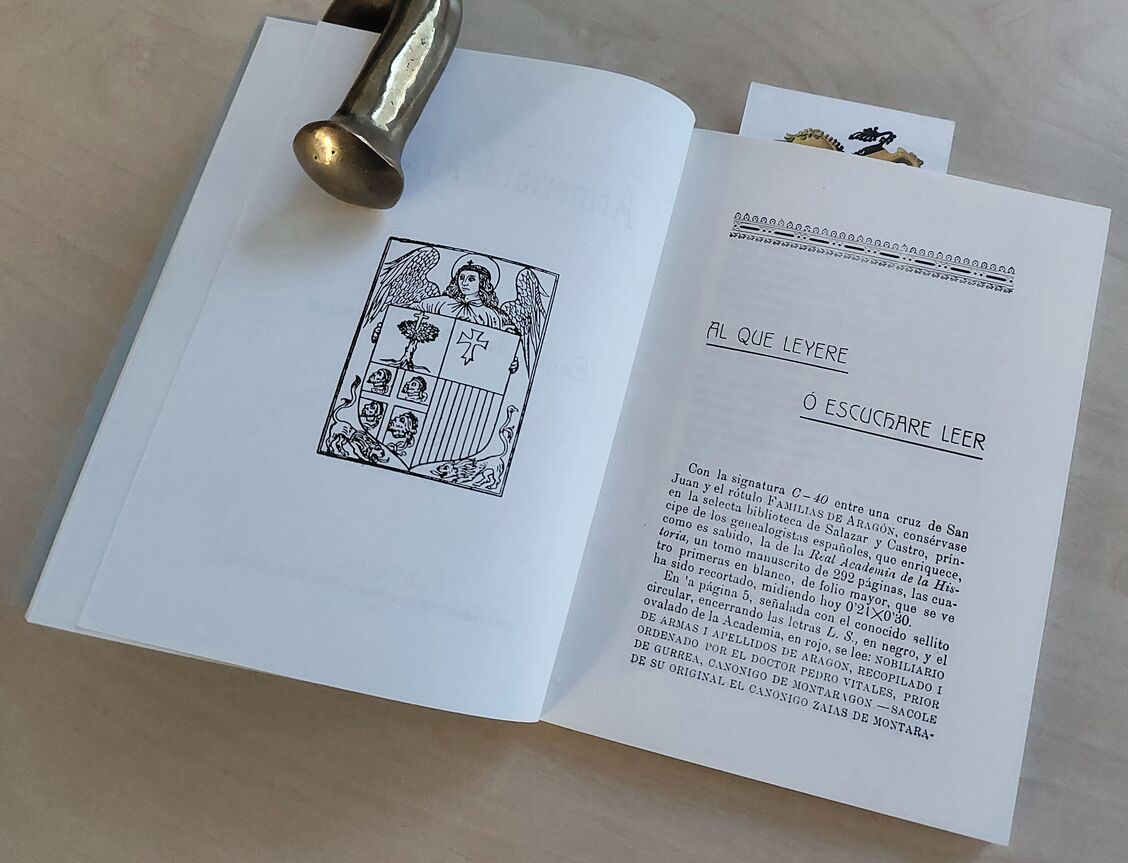Kingdom of Aragon

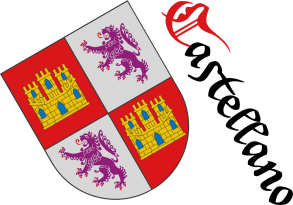
Aragon
Or, four pallets Gules.
Escudo de oro, cuatro palos de gules.
Recreated coat of arms of Aragón in the following manner: the escutcheon shape is pointed and rounded; the field is rendered in flat Or; the pallets are illuminated; and the whole has a parchment-like finish.
This rendition of the coat of arms is based on [Portolés, J.; Molino, M. del; 1590].
Blazon keywords: Without divisions, Or, Four, Pale and Gules.
Style keywords: Ogee, Illuminated and Parchment.
Classification: Interpreted, Civic, Coat of arms and Kingdom of Aragon.
Bearer: Aragon.


Balaguer, municipality of
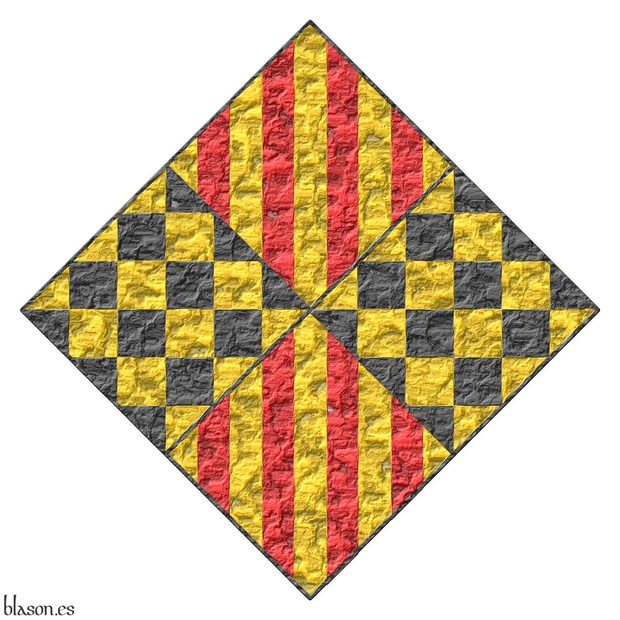
Quarterly per saltire: 1 and 4 Or, four pallets Gules; 2 and 3 chequey Or and Sable.
Escudo cuartelado en sotuer: 1o y 4o de oro, cuatro palos de gules; 2o y 3o ajedrezado de oro y sable.
Arms interpreted with: a lozenge-shaped shield; all tinctures in flat Or, Gules, and Sable; and a heavily beaten metal finish.
Balaguer is the capital of the comarca of La Noguera in the province of Lleida. It was the capital of the county of Urgell under Ponce I of Urgell.
The quartering per saltire, which could also be called quartered in cross, is defined in English as «per saltire», [The Heraldry Society; 2013; page 8].
This coat of arms can be found at [Costa i Cases, P.; Century XVIII; page 15].
Blazon keywords: Quarterly per saltire, Pale, Chequey, Or, Gules and Sable.
Style keywords: Tiled, Plain tincture and Hard metal.
Classification: Interpreted, Civic, Coat of arms and Kingdom of Aragon.
Bearer: Balaguer, municipality of.


Ermengol IX of Urgell
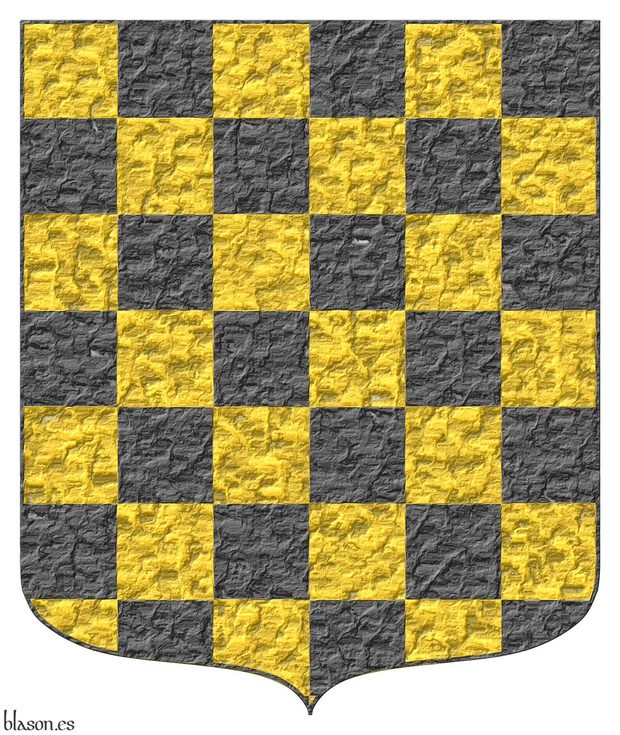
Count of Urgell, Viscount of Àger, deceased in 1243.
Chequey Or and Sable.
Escudo ajedrezado de oro y sable.
Arms interpreted with: a pointed and rounded shield shape; the chequey pattern enamelled in flat Or and Sable; and a heavily beaten metal finish.
Ermengol IX held the county for a very short time, as he died shortly after the death of his father Ponce I of Urgell, in that same year of 1243.
This coat of arms can be found at [Costa i Cases, P.; Century XVIII; page 34].
Blazon keywords: Chequey, Or and Sable.
Style keywords: Ogee, Plain tincture and Hard metal.
Classification: Interpreted, Personal, Coat of arms and Kingdom of Aragon.
Bearer: Ermengol IX of Urgell.


James I of Aragon
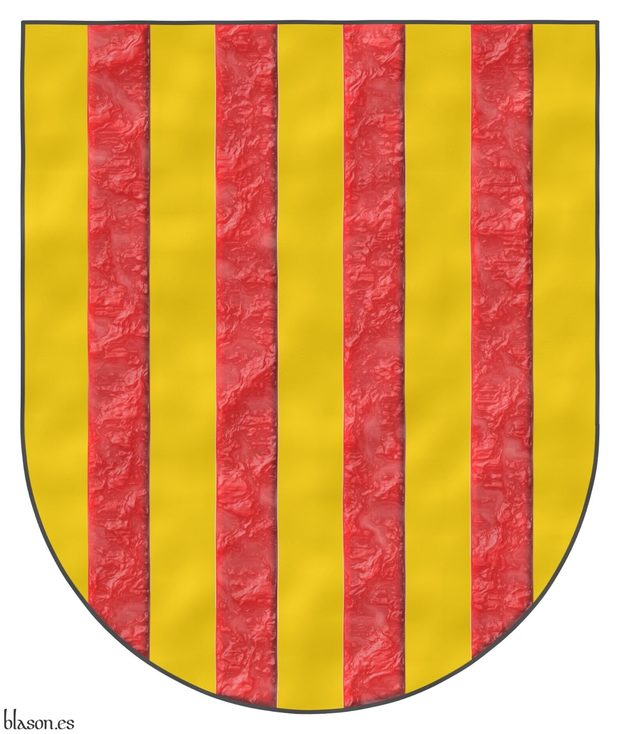
King of Aragon, Valencia and Majorca, Count of Barcelona, Count of Urgell, Lord of Montpellier and known as the Conqueror
Or, four pallets Gules.
Escudo de oro, cuatro palos de gules.
Coat of arms interpreted by me as follows: the escutcheon shape is semicircular; the field is rendered in flat Or with a watercolored effect; and the pallets are illuminated and finished with a crystalline texture.
A semicircular-shaped shield of Aragon can be seen, for instance, in [Argote de Molina, G.; 1588; chapter XLII].
This shield, but with a pointed base, appears in the second part of the armorial [Wijnbergen; 1265; shield no. 1,293], under the title «Le roy Darragon». This second part was compiled between 1270 and 1285 and, since James I was king of Aragon from 1213 to 1276, it could refer to him; although it might also refer to his son Peter III, the Great, who succeeded James I in 1276.
This coat of arms is also the arms of Aix-en-Provence, granted to that French city, according to tradition, by Alfonso II of Aragon [Aix-en-Provence; 1351], grandfather of James I, the Conqueror.
Blazon keywords: Without divisions, Or, Four, Pale and Gules.
Style keywords: Semi-circular, Illuminated, Watercolor and Crystalline.
Classification: Interpreted, Personal, Coat of arms and Kingdom of Aragon.
Bearer: James I of Aragon.


James II of Urgell
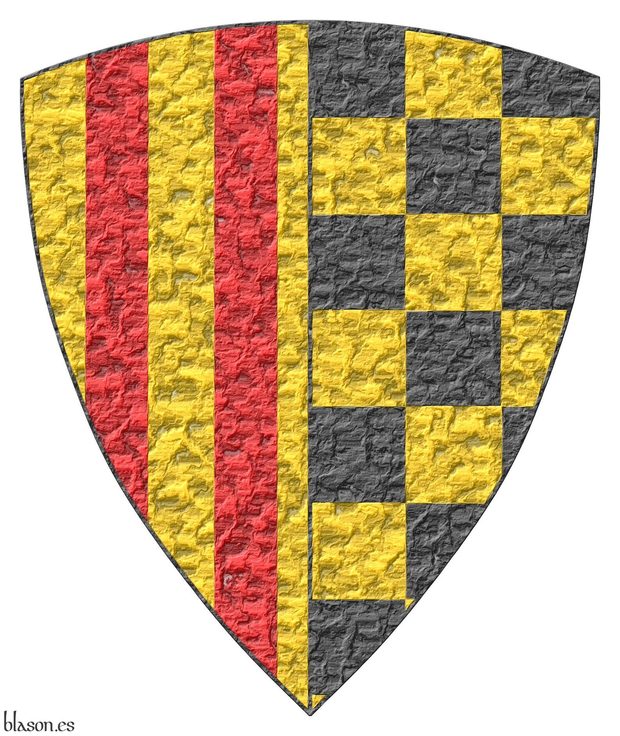
Known as the Unfortunate, Count of Urgell, Viscount of Àger, Baron of Fraga, Antillón and Alcolea de Cinca (1380–1433).
Dimidiated: 1 Or, four pallets Gules; 2 chequey Or and Sable.
Escudo dimidiado: 1o de oro, cuatro palos de gules; 2o ajedrezado de oro y sable.
Arms interpreted with: a shield shape of convex-sided triangles; the tinctures of the pallets and the chequey are flat gold, gules and sable; and the whole design has a heavily hammered metal finish.
James II of Urgell, 1380–1433, known as the Unfortunate, Count of Urgell, Viscount of Àger, and Baron of Fraga, Antillón and Alcolea de Cinca, was one of the main claimants to the throne after the death of Martin I of Aragon. His rejection of the Compromise of Caspe led to his defeat and imprisonment.
Blazon keywords: Dimidiated, Pale, Chequey, Or, Gules and Sable.
Style keywords: Triangular curved, Plain tincture and Hard metal.
Classification: Interpreted, Personal, Coat of arms and Kingdom of Aragon.
Bearer: James II of Urgell.


![Ver [Liñán y Eguizábal, J. de; 1911] en referencias bibliográficas. Libro abierto, hojas de plata, filo de oro, guardas de gules, tapas de sable.](../css/Libro.Bibliografia.png)
Liñán y Eguizábal, J. de; 1911
José de Liñán y Eguizábal, Count of Doña Marina, «Armorial of Aragon», printed by Establecimiento Tipográfico de L. Pérez, Huesca, 1911.
This book is part of a collection that also includes: «Heraldic Mottos» and «Heraldic Dictionary».
A facsimile edition exists, edited by Guillermo Redondo Veintemillas and Alberto Montaner Frutos, published by Institución Fernando el Católico, Zaragoza, 1994.
Bibliographical reference of century XX.
Classification: De bibliotheca, Armorial roll, Dictionary, In black and white and Castilian language.
The author is Liñán y Eguizábal, José de.
External resource:
Internal resources: LinanEguizabalJ1911.ArmorialDeAragon.Color.pdf PDF version scanned in color, although the book is in black and white, it looks more natural, LinanEguizabalJ1911.ArmorialDeAragon.BN.pdf PDF version scanned in black and white, it looks less natural and Facsimile edition in physical paper format.


![Ver [Pedro IV de Aragón; 1353] en referencias bibliográficas. Libro abierto, hojas de plata, filo de oro, guardas de gules, tapas de sable.](../css/Libro.Bibliografia.png)
Pedro IV de Aragón; 1353
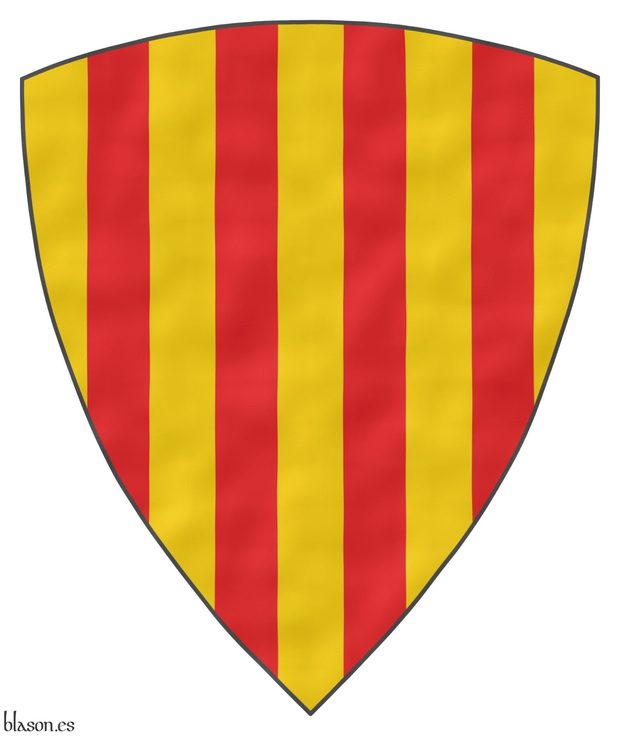
Pedro IV of Aragon, also known as Pedro III of Aragon as he himself called, «Ordinance made by the very high and excellent Prince and Lord Lord Don Pedro the third King of Aragon, on the manner in which the Kings of Aragon will be consecrated and they themselves will be crowned», in the Royal Aragonese Chancery, 1353.
Bibliographical reference of century XIV.
The author is Pedro IV de Aragón.
The following article cites this bibliographic reference:
External link:


Peter II of Urgell
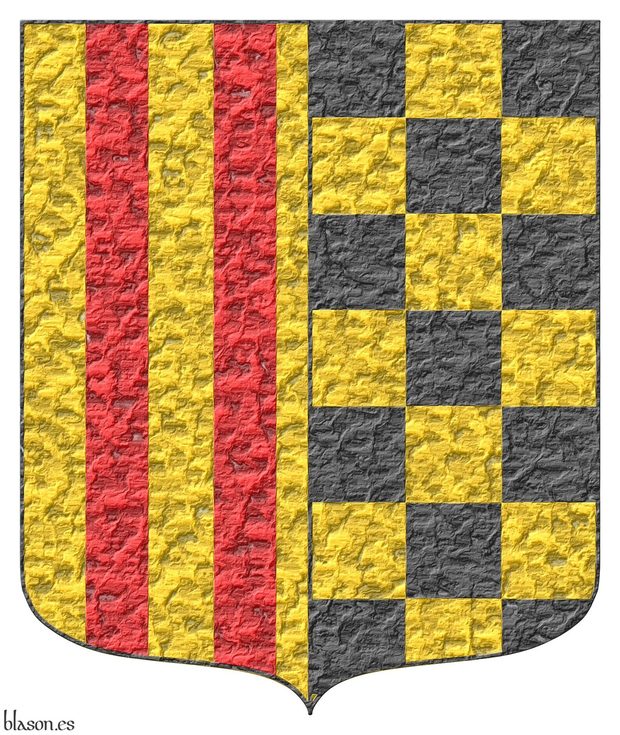
Count of Urgell, Viscount of Àger, Baron of Entença, Antillón, and Alcolea de Cinca (1340–1408).
Dimidiated: 1 Or, four pallets Gules; 2 chequey Or and Sable.
Escudo dimidiado: 1o de oro, cuatro palos de gules; 2o ajedrezado de oro y sable.
Arms interpreted with: the escutcheon in a pointed and rounded shape; the tinctures of the pales and the chequey rendered in flat inks Or, Gules, and Sable; and the whole finished with a highly hammered metal effect.
Peter II of Urgell (1340–1408), Count of Urgell, Viscount of Àger, and Baron of Entença, Antillón, and Alcolea de Cinca, was a prominent figure of 14th-century Catalan nobility and grandson of Alfonso IV of Aragon.
Blazon keywords: Dimidiated, Pale, Chequey, Or, Gules and Sable.
Style keywords: Ogee, Plain tincture and Hard metal.
Classification: Interpreted, Personal, Coat of arms and Kingdom of Aragon.
Bearer: Peter II of Urgell.


Peter IV of Aragon

And II of Valencia and of Ampurias, I of Mallorca and Sardinia, and III of Barcelona.
Or, four pallets Gules.
Escudo de oro, cuatro palos de gules.
Coat of arms of this king of Aragon interpreted by me as follows: the escutcheon shape is curved triangular; the field and the 4 pallets are rendered in flat tinctures Or and Gules; and the whole shield has a watercolored finish.
This curved triangular shape of the escutcheon is inspired by the shield shown in the lower central part of a document issued by the king himself [Pedro IV de Aragón; 1353].
Blazon keywords: Without divisions, Or, Four, Pale and Gules.
Style keywords: Triangular curved, Illuminated and Watercolor.
Classification: Interpreted, Personal, Coat of arms and Kingdom of Aragon.
Bearer: Peter IV of Aragon.


Ponce I of Urgell
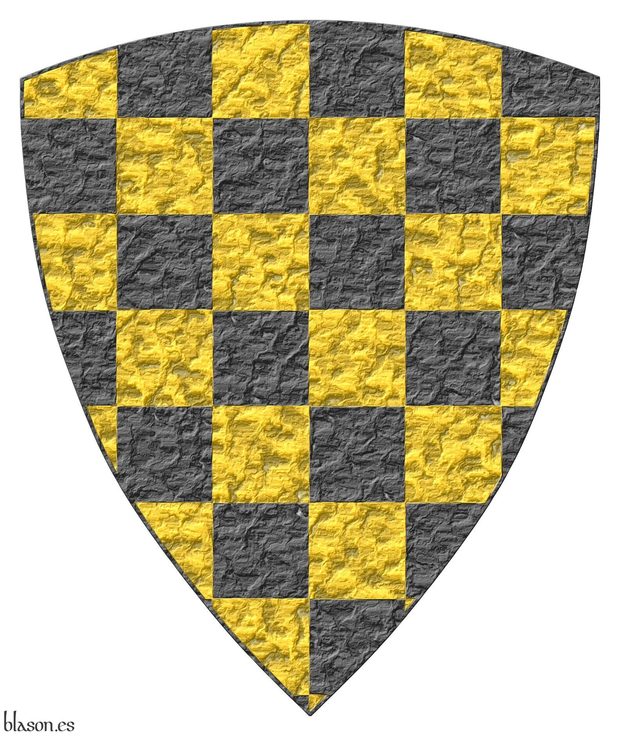
Count of Urgell, Viscount of Àger, deceased in 1243.
Chequey Or and Sable.
Escudo ajedrezado de oro y sable.
Arms interpreted with: a shield shaped as a triangle with curved sides; the chequey pattern in flat metal Or and colour Sable; and a heavily beaten metal finish.
[Avilés, J.; 1780a; page 286] states that he will call «Chequey those ordinaries composed of these small squares, which alternate between metal and colour, or vice versa, just like the boards of those Games.» and he also writes regarding the usual number of panes that «it must have six ranks or rows of these squares, though it is not necessary to specify their number, or at least the shield must include more than fifteen panes; it is only required, to properly blazon it, to always observe the first square, which is in the chief dexter; so that, if this is Or, and the one that follows is Gules, it is said to be Chequey Or and Gules, and so with other colours and metals.»
Although Ponce initially proclaimed himself count of the county of Urgell without sufficient rights, the death of the legitimate heiress and his agreements and assistance to king James I of Aragon enabled him to legalise his title. During this process, the capital of the county ceased to be the municipality of Balaguer only to eventually become it once again.
Blazon keywords: Chequey, Or and Sable.
Style keywords: Triangular curved, Plain tincture and Hard metal.
Classification: Interpreted, Personal, Coat of arms and Kingdom of Aragon.
Bearer: Ponce I of Urgell.


Teresa of Entenza
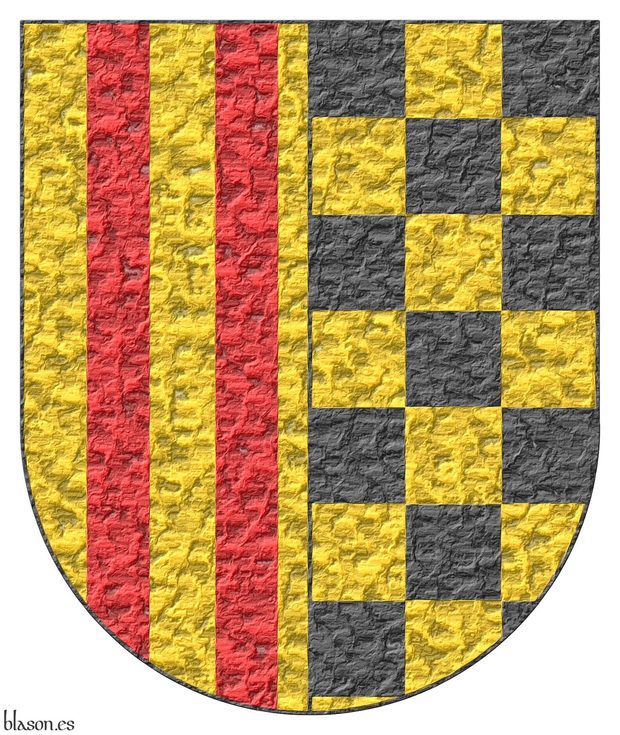
Countess of Urgell, Viscountess of Ager, Lady of Alcolea de Cinca, died in 1327.
Dimidiated: 1 Or, four pallets Gules; 2 chequey Or and Sable.
Escudo dimidiado: 1o de oro, cuatro palos de gules; 2o ajedrezado de oro y sable.
Arms interpreted with: a round-bottom shield; all tinctures in flat Or, Gules, and Sable; and a heavily beaten metal finish.
A dimidiated coat of arms is the result of combining two shields of arms by taking the dexter half of the first and the sinister half of the second.
Dimidiation was used in the 13th and 14th centuries to combine, for instance, the arms of two families.
Its blazoning method does not consist of describing what appears in each of the resulting quarters, but rather, by stating from the beginning that it is dimidiated, describing the original coats of arms. Thus, in this particular case of the arms of Teresa of Entenza, it is not stated that there are only two pallets in the first quarter, but that it is dimidiated and has four pallets, so the reader must know that from the four pallets, only the first two are visible due to the dimidiation.
This method of dimidiating the arms of predecessors results in very beautiful and original designs, but depending on the charges and figures involved, in other cases the result may be unrecognisable or even absurd.
Blazon keywords: Dimidiated, Pale, Chequey, Or, Gules and Sable.
Style keywords: Semi-circular, Plain tincture and Hard metal.
Classification: Interpreted, Personal, Coat of arms and Kingdom of Aragon.
Bearer: Teresa of Entenza.


Urgell, County of
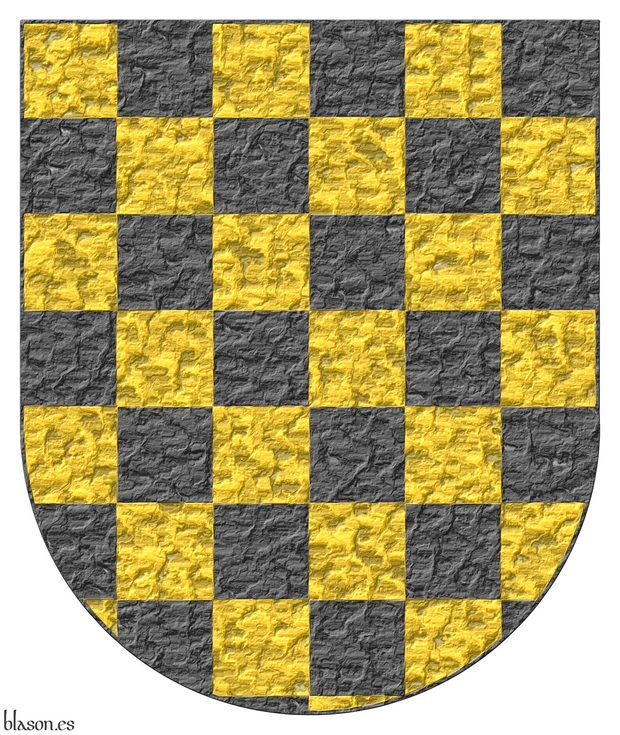
Chequey Or and Sable.
Escudo ajedrezado de oro y sable.
Arms interpreted with: a round-topped shield shape; the chequey pattern in flat metal Or and colour Sable; and a heavily beaten metal finish.
[Avilés, J.; 1780a; page 33] writes about the application of the chequey pattern to shields, ordinaries and charges: «chequey is said of the shield, the principal ordinaries, and even some animals, such as eagles, lions, and other charges, when they are composed of alternating square pieces in the fashion of a chessboard.» On the minimum number of panes he generally specifies that «for a shield to be called chequey, it must have at least twenty chessboard panes; because if it has only nine, it is called equipoll; and if it has fifteen, it is said to be of fifteen panes of chequey» and for its application to ordinaries that «other ordinaries, such as bends, fesses, etc., must have at least two rows of chequey to be considered chequey, otherwise they would be called compony.»
Blazon keywords: Chequey, Or and Sable.
Style keywords: Semi-circular, Plain tincture and Hard metal.
Classification: Interpreted, Civic, Coat of arms and Kingdom of Aragon.
Bearer: Urgell, County of.
-
Language
-
Categories of heraldry
-
Divisions of the field
- Without divisions
- Party per pale
- Party per fess
- Party per bend
- Party per bend sinister
- Tierce
- Tierce sinister
- Tierced per pale
- Tierced per fess
- Tierced per bend
- Tierced pallwise inverted
- Quarterly
- Quarterly per saltire
- Gyronny
- Party per fess, the chief per pale
- Party per pale, the sinister per fess
- Party per fess, the base per pale
- Party per pale, the dexter per fess
- Chapé
- Chaussé
- Embrassé
- Contre-embrassé
- Party per chevron
- Enté
- Enté en point
- Flanched
-
Metals
-
Colours
-
Furs
-
Other tinctures
-
Ordinaries and sub-ordinaries
-
Diminutives of the ordinaries
-
Geometric charges
-
Composite ordinaries
-
Inanimate charges from Nature
Atom, Crescent, Diamond, Emerald, Estoile, Increscent, Lightning flash, Moon, Mount, Mullet, Mullet of four points, Orbital, Plough of Ursa Major, Rainbow, Ray of the sun, River, Sea, Snowflake, Sun, Sun in splendour, Sun of May, Trimount, Water and Wave.
-
Vegetal charges from Nature
Acorn, Apple, Apple tree, Ash, Bluebonnet, Camellia, Chrysanthemum, Cinquefoil, Cornflower, Dogwood flower, Double rose, Elm, Fleur de lis, Flower, Gourd, Holm oak, Hop cone, Kapok tree, Laurel, Lily, Linden, Lotus flower, Madonna lily, Mexican cedar tree, Oak, Olive tree, Palm tree, Plantain plant, Pomegranate, Poplar leaf, Rose, Shamrock, Sunflower, Thistle, Tree, Tulip, Vine and Wheat.
-
Animal charges from Nature
Badger, Bald eagle, Barbel, Barn owl, Bear, Beaver, Beetle, Bighorn sheep, Blackbird, Boar, Brach hound, Bull, Doe, Dog, Dolphin, Dove, Eagle, Elephant, Falcon, Female figure, Fish, Flame, Fly, Fox, Frog, Goat, Goldfinch, Goose, Heron, Horse, Hummingbird, Jaguar, Lark, Leopard, Lion, Lion passant, Lion rampant guardant, Lioness, Lynx, Male figure, Martlet, Merino ram, Owl, Panther, Parrot, Peacock, Pelican, Pelican in her piety, Puffin, Quetzal, Raven, Roe deer, Rooster, Savage, Seagull, Serpent, She-wolf, Stag, Starling, Talbot, Tyger, Vulture, Warren hound and Wolf.
-
Parts of natural charges
Arm, Beak, Branch, Caboshed, Chest, Claw, Covert, Dorsal fin, Eagle claw, Ermine spot, Escallop, Feather, Foot (palmiped), Foreleg, Forepaw, Hand, Head, Heart, Hoof, Leaf, Neck, Ostrich feather, Palm frond, Paw, Roe deers' attires, Shoulder, Sprig, Stags' attires, Stem, Swallow-tail, Tail, Tail addorsed, Tail fin, Talon, Tibia, Tooth, Trunk, Trunk (elephant), Two hands clasped, Two wings in vol, Udder, Wheat spike, Wing and Wrist.
-
Artificial charges
Ace of spades, Anchor, Anvil, Arch, Arm vambraced, Armillary sphere, Arrow, Axe, Bell, Bell tower, Beret, Bonfire, Book, Bookmark, Bow, Branding iron, Bridge, Broken, Buckle, Cannon, Cannon dismounted, Cannon port, Canopy roof, Carbuncle, Castle, Celtic Trinity knot, Chain, Chess rooks, Church, Clarion, Clay pot, Closed book, Club, Column, Comb, Compass rose, Conductor's baton, Cord, Covered cup, Crozier, Crucible, Cuffed, Cup, Cyclamor, Dagger, Double vajra, Drum, Ecclesiastical cap, Fanon, Federschwert, Fleam, Four crescents joined millsailwise, Galician granary, Garb, Gauntlet, Geometric solid, Grenade, Halberd, Hammer, Harp, Host, Hourglass, Key, Key ward, Knight, Knot, Lantern, Letter, Line, Loincloth, Menorah, Millrind, Millstone, Millwheel, Monstrance, Mortar, Mullet of six points pierced, Nail, Non-classic artifact, Norman ship, Number, Oar, Oil lamp, Open book, Page, Pair of scales, Parchment, Pestle, Piano, Pilgrim's staff, Plough share, Polish winged hussar, Port, Portcullis, Potent, Quill, Ribbon, Rosette of acanthus leaves, Sabre, Sackbut, Sail, Scroll, Scythe, Sheaf of tobacco, Ship, Skirt, Spear, Spear's head, Stairway, Star of David, Step, Sword, Symbol, Tetrahedron, Torch, Tower, Trident, Trumpet, Turret, Two-handed sword, Wagon-wheel, Water-bouget, Wheel, Winnowing fan and With a turret.
-
Immaterial charges
Angel, Archangel, Basilisk, Dragon, Dragon's head, Garuda, Golden fleece, Griffin, Heart enflamed, Justice, Mermaid, Our Lady of Mercy, Ouroboros, Paschal lamb, Pegasus, Phoenix, Sacred Heart of Jesus, Saint George, Sea-griffin, Trinity, Triton, Unicorn, Winged hand and Wyvern.
-
External elements
-
Heraldic creations
-
References
-
Formats
-
Keywords on this page
Watercolor, Chequey, Parchment, Aragon, Armorial roll, Balaguer, municipality of, Bibliography, Ogee, Crystalline, Quarterly per saltire, Four, De bibliotheca, Dictionary, Dimidiated, In black and white, Ermengol IX of Urgell, Coat of arms, Personal, Gules, Illuminated, Interpreted, James I of Aragon, James II of Urgell, Castilian language, Tiled, Semi-circular, Hard metal, Or, Pale, Peter II of Urgell, Peter IV of Aragon, Without divisions, Civic, Ponce I of Urgell, Kingdom of Aragon, Sable, Century XIV, Century XX, Teresa of Entenza, Plain tincture, Triangular curved and Urgell, County of.

